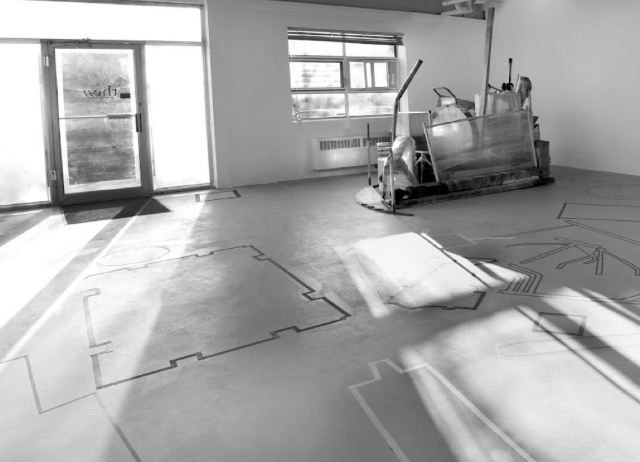
Georgia Dickie’s “Six Hundred and Seventy Eight Feet” from Sterling Road. Installed and removed by Stephanie Fielding, Danielle Bessada, Vanessa Maltese, Renee Dykeman, Georgia Dickie and Sebastian Frye. Photograph: Lili Huston-Herterich
TORONTO — On January 11th, Toronto artists and studio mates Lili Huston-Herterich, Vanessa Maltese and Abby McGuane were informed by their landlords of a 55% rent increase for February. This means their studios, located at a two-storey factory on Sterling Road, would jump from $1,905.50 CDN per month to $2,964.50.
The artists weren’t alone — indeed, as first reported in the Toronto Star, the landlords increased the rent across the board, with other artist and small business tenants also being forced to vacate the formerly desolate industrial zone in Toronto’s lower Junction neighborhood. The rapid revitalization along Sterling Road is bittersweet — despite the Museum of Contemporary Canadian Art’s imminent move to the historic Tower Automotive Building at 158 Sterling next year, as well as new developments like “limited edition townhouses”, artists are getting pushed out of their live/work studios to be converted into offices for film production and advertising companies.
But the artists, who had lived in the neighborhood for five years, decided to mark their departure with a publication detailing this pivotal transitional period. Made with contributions from over forty past and present tenants within the past month — including emerging and established artists, craftspeople and architects — Sterling Road (published by Swimmers Group, and launching privately this Saturday) reflects on the histories being erased. “There is so much to say about artists’ relationships with developers, but the one thing I do believe is that there is a space and the capacity for conscious development,” says Huston-Herterich. “The growing city is inevitable, but there are many ways this evolution can happen. We hope to play a more active role in these changes.”
Following are edited excerpts from an email conversation with Vanessa Maltese, Lili Huston-Herterich and Abby McGuane regarding the city’s dwindling affordable work spaces, how the book came together, and whether or not the trend of creative placemaking truly benefits artists.

One of Niall McLelland’s contributions to the Sterling Road publication. Credit: McLelland/Swimmers Group
Rea McNamara: Why was it important to make this document of the past five years on Sterling?
Vanessa Maltese: The Sterling Road publication is about community and the type of power it can harness. We built small empires on this street, made friends and colleagues. Two of my most crucial fabricators, Lauren Reed and Andrew Beintner, worked in spaces off of the same parking lot as we did.
Rea McNamara: Many of the artists who contributed to this publication were part of MoCCA’s 2012 Trans/FORM group show, and the Sterling Road connection was noted at the time as an aspect of the show’s curation. Now that the museum has moved, is there a sense of irony the artists are moving out?
Lili Huston-Herterich: Ironic, yes, but not atypical. The site of the old MoCCA on Queen West followed a similar trajectory in urban development when it moved there in 2005.
Our purpose in this conversation is to encourage a more conscious and educated approach to urban development in the city, so building owners like ours understand there is a much larger impact in the community when they make a decision like this in a creative neighbourhood.

Derrick Piens’s contribution to the Sterling Road publication. Credit: Piens/Swimmers Group
Rea McNamara: Is purchasing real estate the best defense against rising rent costs?
Lili Huston-Herterich: Our economic standing is a huge deterrent from purchasing practical real estate. However, there are options to co-own property, or do some collaborative development of our own — working with an architect has made me understand a bit more fully the real power and capacity of our creative network in that regard. There must be a delicate balance of both, regardless — protection and power to artists (and all makers!) as renters and owners alike.
Abby McGuane: Being able to purchase property would be ideal, but that’s pretty unrealistic for most of us. Better rent protection on commercial leases would also be great, but then what landlord would want to rent to an artist? Over the past year walking up and down Sterling Road, I have seen numerous companies open offices, some with windows facing the street. I just find it so absurd, seeing these people working at computer desks, in vast spaces with 15-foot ceilings. Like, what do you need this for? You could literally work anywhere. Meanwhile, our neighbours in the wood shop below us will have to go so far out of the city centre to find a space that meets their needs, their businesses will no doubt be affected.

Brendan Flanagan’s contribution to the publication. Credit: Flanagan/McGuane/Swimmers Group
Rea McNamara: Toronto’s seeing developers like Daniels work with the city to make “space” in their developments for galleries, studios, arts centres. Their Daniels Spectrum cultural hub in Regent Park, but also the recently unveiled High Park condos and the permanent public art commission by Public Studio, come to mind. (Lili, I know you were involved with the latter.) Is this trend encouraging, or more complicated?
Lili Huston-Herterich: In the case of Daniels’ new projects, there is a focus on public art, utilizing the city’s Percent for Public Art program for new developments, which is how the public works of Public Studio — Elle Flanders and Tamira Sawatzky, the artists I work for — came about. Although it is different in its outcome, it is a notable example of the city, alongside developers, committing to the cultural landscape of Toronto.
Daniels has also been a participant in other projects of mine, including a work installed at Art Museum at U of T that includes photographs of their showroom condo units…so I’m really involved in this type of dialogue about the site of the new domestic, and the changing landscape of the city.
Abby McGuane: It’s complicated, for sure. Some of these developers seem to be taking a greater initiative than others. Obviously any funding or opportunity offered to the creative community is better than nothing, but ultimately these companies are making bank off the credibility they get from appearing to be benevolent by being involved in the local art scene. A public art commission is great, and so is another exhibition space, but things like that don’t actually encourage artistic production on a wider scale — they don’t keep communities diverse. The intended audience for these initiatives is the consumer, the condo-dweller. Perhaps they’ll be inspired to buy a painting, who knows.

One of Vanessa Maltese’s contributions to Sterling Road. Credit: Maltese/Swimmers Group
Rea McNamara: After the Toronto Star broke the news last month, what support have you received from the local arts community?
Vanessa Maltese: The Toronto Star article succeeded in reaching an audience far beyond our immediate community. People came out of the woodwork. Other building owners shared upcoming vacancies and creatives from the surrounding area introduced themselves with their contributions to the publication. We are lucky to have found a space that suits us in such a short time frame and are grateful for all the helping hands that were extended to us in the process.
Rea McNamara: What’s been the case for the other Sterling Road tenants?
Abby McGuane: Some have found live/work situations in single family homes with garages, others are moving closer to the Stockyards [located in the Northeastern part of the Junction]. We are not entirely sure where everyone has settled, as we are still in the midst of the scramble to set up our new working space in a neighborhood that will eventually also undergo a transformation with an imminent condo development on the horizon — so we aren’t deluded to think this is a permanent solution.
We were lucky to find a space that’s still downtown. It’s a great space, and we’re going to use it to its fullest, for as long as we can.


Comments on this entry are closed.